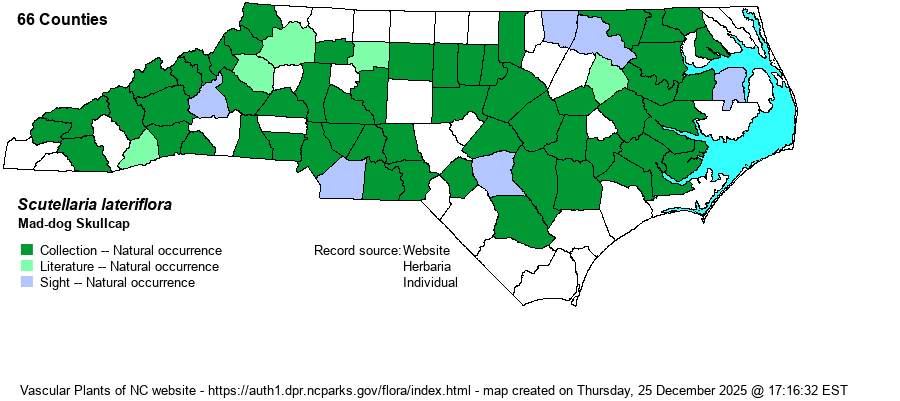| Author | L. | |
| Distribution | Scattered across the entire state, but likely absent along the immediate coast, with no records yet for any coastal county.
This is a very widespread species from east to west, ranging from Canada south barely to northern FL and to CA. | |
| Abundance | Generally infrequent across the state, to at least locally fairly common. Despite records on the map for over 65 counties (nearly two-thirds of the state's 100 counties), this is certainly not close to a common species. However, Weakley's (2018) map shows it as "common" in all three provinces, but that is based mostly on number of county records and not actually in-the-field abundance. However, the website editors suggest moving the S4 State Rank assigned by NCNHP to S4S5, owing to its wide range. | |
| Habitat | This is an obligate wetland species, found most often in openings in swamps and bottomlands, along pool margins, in marshes and bogs, and in seepages. | |
| Phenology | A fairly late-blooming Scutellaria, from July to frost, and fruits soon after flowering. | |
| Identification | This is a somewhat openly branched skullcap and is seldom a strict, narrow stem. It grows to about 1.5-2 feet tall, and often at least half as broad. It has numerous paired leaves, each with a moderate petiole, and an ovate to narrowly ovate blade, about 2 inches long and about 3/4-inch wide, serrated on the margins, with a rounded base. It is a very "floriferous" species, with short racemes in quite a few axils of the branches, each raceme several inches long and containing many small flowers but all facing the same direction (i.e., a one-sided raceme). Each flower is only about 2/5-inch long, but usually bright blue, rarely pink to white. Thus, in most Scutellaria species, one often notices individual flowers, but in the species, one notices the many one-sided racemes, and to study each flower you must bend down to get a close look. It is not common, but it is widespread enough to be encountered a few times in a given year by an active biologist. And, it arguably does have the brightest blue flowers in the genus in the state. | |
| Taxonomic Comments | None
| |
| Other Common Name(s) | Tall Blue Skullcap, Blue Skullcap, American Skullcap | |
| State Rank | S4 [S4S5] | |
| Global Rank | G5 | |
| State Status | | |
| US Status | | |
| USACE-agcp | OBL link |
| USACE-emp | FACW link |

